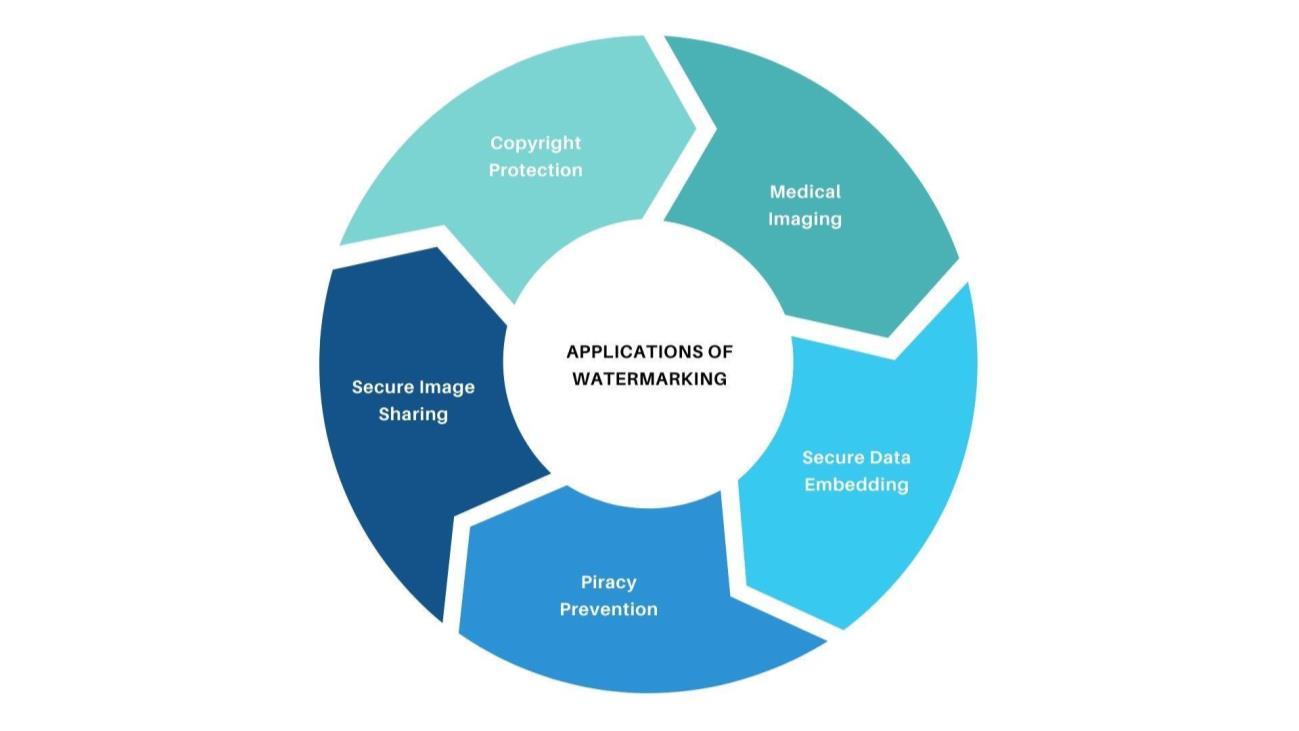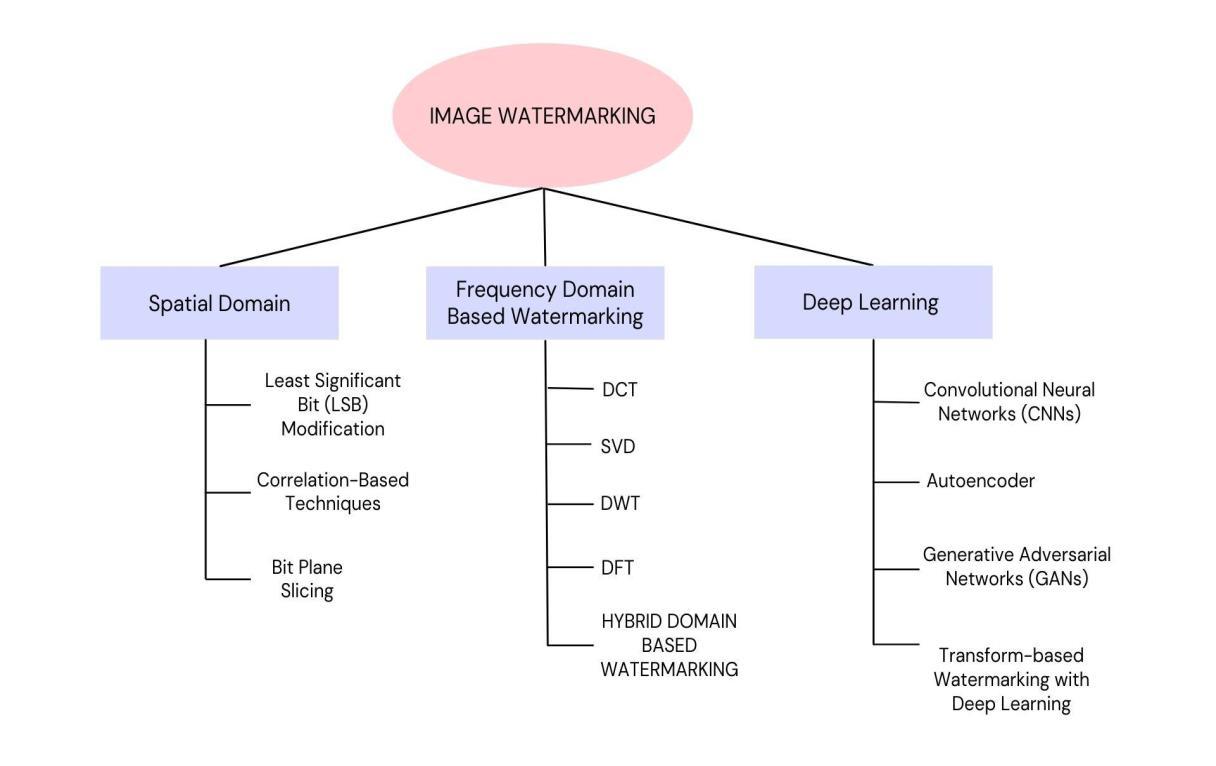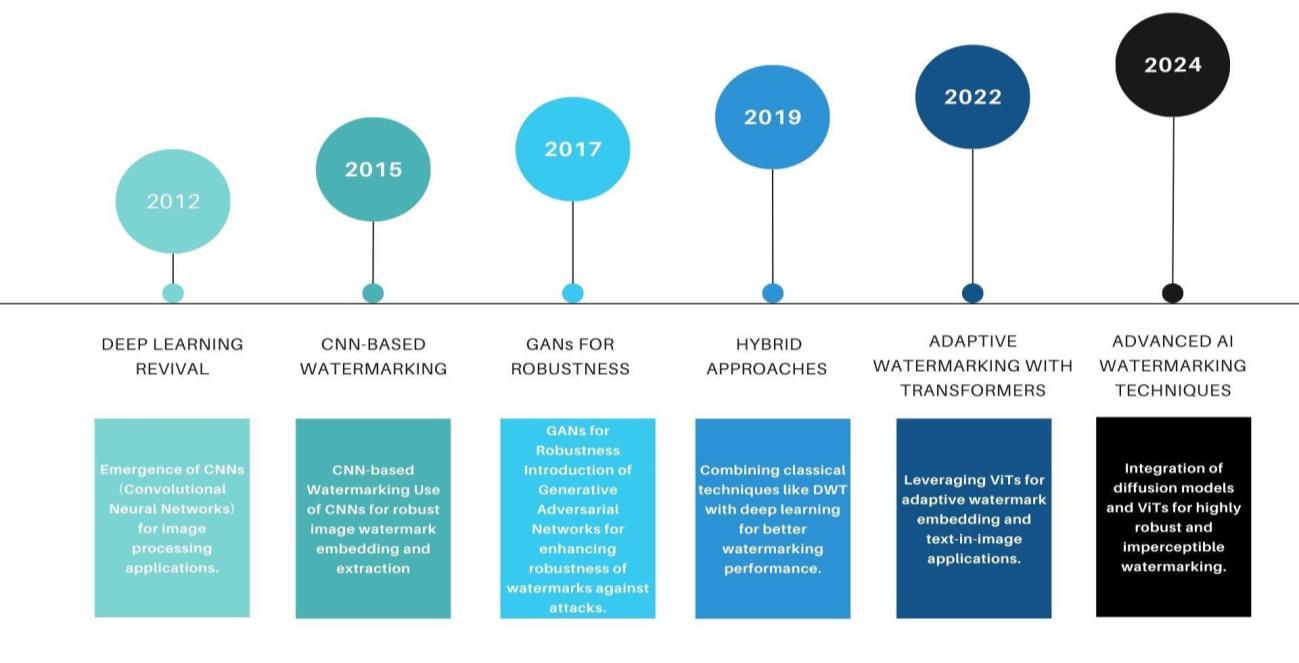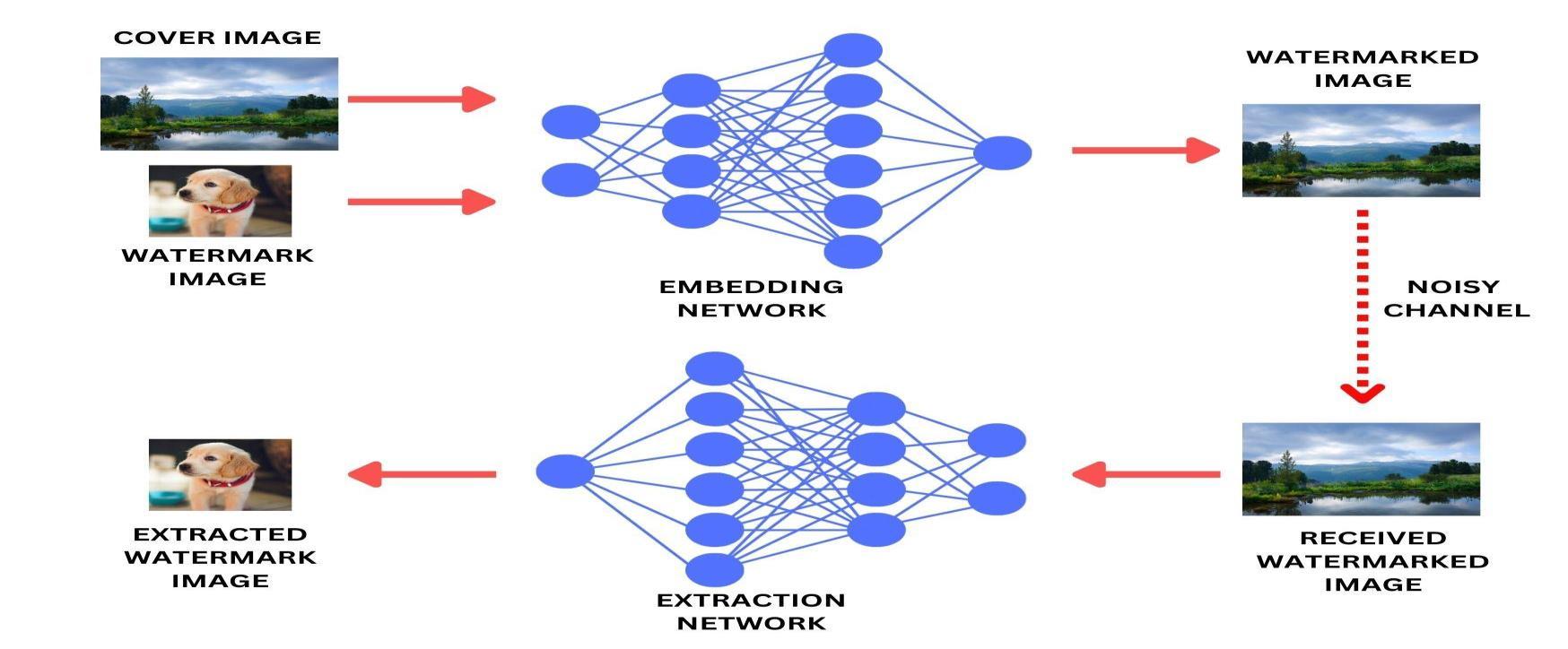
International Research Journal of Engineering and Technology (IRJET) e-ISSN:2395-0056
Volume: 12 Issue: 01 | Jan 2025 www.irjet.net p-ISSN:2395-0072


International Research Journal of Engineering and Technology (IRJET) e-ISSN:2395-0056
Volume: 12 Issue: 01 | Jan 2025 www.irjet.net p-ISSN:2395-0072
Vishal Singh1 , Ayush Aggarwal2 , Vidit Biswas3 , Amrit Kumar Agarwal4
Sharda University, Greater Noida ***
Abstract
With the dawn of advanced automatic learning and hybrid methods, water marking technology has seen transformative strides. This article analyzes those emerging technologies that are redefining the power, invisibility, and efficiency of digital water marking systems. Highlight the latest innovation and explore deep learning architectures like convolutional neuronal networks, generative adversarial networks, and models based on automatic coders. The hybrid framework combines traditionalstrategies ofsignalprocessing andneuronalnetworksandevaluatesits abilitytobalancefidelity andflexibility in the presence of distortion. The review also highlights key approaches such as attention mechanisms and multi-domain learning models that can improve performance in diverse application scenarios. Through comparative analysis of these techniques,thisarticleidentifiesthelimitationsofthecurrentapproachandprovidespracticalknowledgeforfutureresearch, particularlyintheareasofadversarialrobustness,scalability,andmultimodalapplications.Throughthisintegralexploration, thisresearchaimstoprovideabasicreferencetopromotethedevelopmentofdigitalwatermarkingtechnology.
In the era of digital media, the integrity and ownership of the multimedia assets should be assured. Digital image watermarking has emerged as an essential technique for fusion and extraction of hidden information as well as intellectual property protection against manipulation or unauthorized copies [1]. Though traditional methods have become a necessity, thelimitedadaptabilityandsensitivitytothemodernthreatscallfornewapproaches[1][2].
Deeplearninghasreallyrevampedthewatermarkingdomainthatwasonceastaticcasespecificsystemtoadynamic,flexible field that is now applicable to solve several operational issues. Current research has effectively utilized the unique ability of learning of DNNs for automating and generalizing algorithms for watermarking along with achieving robustness and imperceptibility [3] [4]. For example, autoencoder-based frameworks improve the embedding and extraction process, ensuringbetterrobustnessandmissingnessmetricssuchashigherPSNRandSSIMvalues[2][4].
Recentadvancesalsobroughtinnewarchitecturaldesigns,suchas discretewavelettransformscombined withDNNs,multitasklearning,andattentionmechanisms.Thesetechniquesenhancetherobustnessofwatermarkingagainstdifferenttypesof distortion, such as noiseaddition, cropping, andcompression[5][6][7].Anothertechnique, static domainlearning andjoint training of adversarial networks, also solves the incorrect operation and multiple attack scenarios, breaking the robustness andfidelitylimitsofwatermarkingsystems[5][8].TheapplicationsofwatermarkingareshowninFigure1.

International Research Journal of Engineering and Technology (IRJET) e-ISSN:2395-0056
Volume: 12 Issue: 01 | Jan 2025 www.irjet.net p-ISSN:2395-0072

Thispaperexplores state-of-the-artmethods forimage watermarking, focusingontheadaptability, robustness, andpractical applications of deep learning-based schemes. The challenge to existing problems, the combination of principles from cryptographyandneuralnetworks,aresettocreatenewstandardsinthefieldwhileprovidingsecureandeffectivecopyright protectioninthedigitalage[1][9].
2.1 Watermarking Techniques
Historically, watermarking techniques have been based on spatial and domain transformation methods like DCT, DWT, and SVD. These methods embed the watermark in the spatial or frequency components of the image so that it is not visible and does not look slightly distorted. For instance, DCT allows adding of watermarks without image degradation where optical sensitivity is very weak and thus image quality will remain good while DWT does resist lossy compression. Although these methods have their advantages, they often fail underhigh-resolutiondistortions such as high-density noise, severeshearing, andgeometricchanges,whicharebecomingincreasinglycommoninpracticalapplications.Zhangetal.[10]combined
DCTwithaDarkNet53-basedneuralnetworktoachieveanormalizedcorrelation(NC)valueof1.0underGaussiannoiseand scalingattacks.Scalability,vulnerabilitytoadversarialattacks,andtheneedformanualoptimizationmeanthatthereisstilla greatneed fordevelopingadvancedwatermarking methodsusingdeeplearning. Thetaxonomy ofwatermarkingisshownin Figure2.

International Research Journal of Engineering and Technology (IRJET) e-ISSN:2395-0056
Volume: 12 Issue: 01 | Jan 2025 www.irjet.net p-ISSN:2395-0072

Deep learning has transformed watermarking technology by introducing models that automatically learn and adapt to complex embedding and extraction scenarios. These systems exhibit improved degaussing, robustness, and adaptability comparedtotraditionalmethods.TheevolutionofdeeplearninginwatermarkingisdepictedinFigure3.


International Research Journal of Engineering and Technology (IRJET) e-ISSN:2395-0056
Volume: 12 Issue: 01 | Jan 2025 www.irjet.net p-ISSN:2395-0072
Deep learning has transformed the art of digital watermarking by presenting powerful and imperceptible techniques using advancedneuralnetworkarchitectures.
Zhong et al. [3] and Zhang et al. [10] presented a convolutional neural network (CNN) for automatic watermark embedding and extraction. These methods significantly enhance the recovery from distortions like salt and pepper noise and Gaussian noise. Zhang et al. [10] also view watermarking as an embedding task of an image. This makes the embedding procedure easier,withhighimperceptibilityandlowbiterrorrate(BER)evenunderadverseconditions,suchas65%croppingorstrong compressionratios.
GANsaddarevolutionarylayertothedeeplearningframework.Dengetal.[5]proposedaGAN-basedwatermarkingscheme that achieved excellent robustness against hybrid attacks like JPEG compression and salt and pepper noise, with NC values greater than 0.98. The effectiveness of the method in sensitive applications, such as medical imaging where PSNR reaches 56.82 dB and SSIM reaches 1,000, points out its significance in getting a robust imperceptible watermark. Zhao et al. [20] further extended this idea to incorporate an attention mechanism toward achieving semantic-aware watermarking through spatialandchannelattentionweights.
Autoencoderarchitectureisanotherinterestinginnovationofdeeplearningforthisfield.Singhetal.[11]appliedCNN-based autoencoderthatwasabletosustaina PSNRvalueupto31.34dB andanNCupto0.9937invarious distortionssuchassalt and pepper noise and JPEG compression. Wu et al. [6] achieved this by introducing an iterative training strategy, training separate encoders and decoders to achieve 94.82% bit prediction accuracy (BPA) under JPEG compression (QF = 50). These contributionshighlightthediversityandpowerofdeeplearningframeworksfordigitalwatermarking.ASystematicdiagram forwatermarkingusingdeeplearningisshowninFigure4.

Figure 4: ASystematicdiagramforwatermarkingusingdeeplearning

International Research Journal of Engineering and Technology (IRJET) e-ISSN:2395-0056
Volume: 12 Issue: 01 | Jan 2025 www.irjet.net p-ISSN:2395-0072
Hybrid frameworks combine traditional signal processing approaches with modern deep learning models to balance invisibility with computational power and efficiency. Wei et al. [2] combined DWT with Periodic Variational Autoencoder (Cycle-VAE)toformahybridframework.Thetwo-cycleconsistencymechanismpreservesthewatermarkimagefidelitywith an imperceptible PSNR value reaching 37.91 dB and an NC value almost close to 1.0 against geometric distortion and noise. Takingthisfurther,Weietal.[15]proposedadouble-ringmechanismthatgreatlyimprovedrobustnessbykeepingtheSSIM valueover0.94evenagainstseverenoiseanddistortion.Hybridtechniques,suchasTavakolietal.workin[12],aredeveloped incorporating chaotic labeling and transformation techniques to efficiently counter adversarial attacks. Their approach producesNCvalues above0.9fora widerangeofevolutionsthatprovidea robustsolutionagainstthechallengesofmodern security. These techniques exemplify the promise of hybrid techniques to tap into the potential of traditional and deep learningtechniques.
Huang et al.[13] incorporatedynamic weight averaging (DWA) in themulti-task learning framework to furtherimprove the trade-off between the performance of the main task and watermarking objectives. The system learns faster when used with GoogleNet,whileachieving100%accuracyinwatermarkextractionatround14versusround24withoutDWA.Forthesame reason,DWAenhancestheclassificationaccuracybyincreasingthevaluefrom98.92%upto99.20%usingsuchdatasources asMNIST,forinstance.
Attention-directed architectures are the other leading class. Huang et al.'s [7] advanced attention mechanism ARWGAN, for instance, seeks to enhance embedding accuracy and distortion restoration capabilities. Their system has established a new benchmarkinPSNRat43.72dBandabitaccuracyofmorethan96%inwatermarkingsystemsintheareasofhealthcareand securetransmissionofcontentrequiringhighconcealmentandrobustness.
Wangetal.[16]proposeanovelapproachtoenhancingmulti-tasklearningforimagewatermarkingbyusingDynamicWeight Averaging(DWA).DWAdynamicallyadjuststhetaskweightsaccordingtothelearningratesofindividualtasks,whichensures balanced optimization across diverse objectives such as embedding and extraction. The approach handles challenges in the traditionalmulti-tasklearningsetupwhereinfixedorstaticweightconfigurationsresultinsuboptimalperformance.Utilizing DWA, improved robustness and effectiveness areachieved for embedding watermarks into the image without degrading the qualityof extractingwatermarksundervariousdistortions. Thescopeofthis researchdemonstratesthepotentialofDWA in advancingimagewatermarkingusingadaptivetaskpriorityalignment.
Chenetal.[17]furtherpushedthewatermarkingtechniqueformedicalimaging,usingWMNet,CNN-basedsystemwithover 97% classification accuracy under distortion, which ensures integrity of data during transmission and maintains diagnostic qualitythatindicatesthepossibilityofspecificindustrysolutionsinwatermarking.
Leeetal.[18]presentadigitalimagewatermarkingprocessorusingdeeplearningalgorithmstoachieverobustandefficient watermark embedding and extraction. The proposed system integrates CNNs for improving the resilience of the watermark against distortions and attacks while preserving the quality of the image. The processor is optimized for real-time performance, making it appropriate for practical applications. Conclusion Conclusion: This study reveals how deep learning can push the technology of digital image watermarking further by balancing the levels of robustness, efficiency, and fidelity involved.
Table 1: Summary of various watermarking methods with performance.

International Research Journal of Engineering and Technology (IRJET) e-ISSN:2395-0056
Volume: 12 Issue: 01 | Jan 2025 www.irjet.net
Wei et al. [2]
Singh et al. [11]
Huang et al.[13]
Mahapatra etal.[22]
Deng et al. [5]
Wu et al. [6]
Deng et al. [14]
Wei et al. [15]
Deng et al. [5]
Zhao et al. [20]
Chen et al. [17]

International Research Journal of Engineering and Technology (IRJET) e-ISSN:2395-0056
Volume: 12 Issue: 01 | Jan 2025 www.irjet.net p-ISSN:2395-0072
Tavakoli et al.[12]
Huang et al.[7]
Gaussian blur, JPEG compres sion
The performance of watermarking techniques is estimated by several key parameters and metrics that decide the trade-offs between imperceptibility, power, and efficiency. Perceptual apraxia is usually evaluated by the peak signal-to-noise ratio, or PSNR,whichcanbecalculatedas:

WhereMAXisthemaximumpossiblepixelvalueoftheimage-forexample,255foran8-bitimage-andMSEisthemeansquare error between the original image and the watermarked image. PSNR values above 30 dB commonly refer to an almost fully imperceptiblewatermarkwhenmaintainingtheimagequalityathighlevels.
Itdeterminesthestrengthofawatermarkthatcouldsurvivedifferentkindsofattacks,suchasnoise,compression,clippingor geometricdistortion.ThemeasuresusedtoquantifyrobustnessareBERandNC.BERisexpressedas:

WherelowerBERindicateshigherrobustness.NCiscalculatedas:

WhereWoW_oWo is theoriginal watermark and WeW_eWe is the extracted watermark. NC values closeto1 indicatestrong resistancetoattacks.
The capacity of a watermark refers to the amount of data that can be embedded without significantly degrading the imperceptibility.Itdependsonthesizeofthehostimageandthemethodofwatermarking.Techniquesthatyieldhighpower whilemaintainingPSNRandrobustnessarepreferredforpracticalapplications.
Embedding and extraction time is very critical in real-time scenarios. Usually, it is measured in seconds or milliseconds dependingonthehardware,anditisverymuchimportantinapplicationslikestreamingordynamicmedia.

International Research Journal of Engineering and Technology (IRJET) e-ISSN:2395-0056
Volume: 12 Issue: 01 | Jan 2025 www.irjet.net p-ISSN:2395-0072
Robustness of the watermarking method against different types of attacks, including noise (e.g., Gaussian, Salt and Pepper), compression (e.g., JPEG), and geometric transformations (e.g., cropping, rotation) is tested. In such conditions, low BER and highNCprovethatthisapproachisresilient.
Finally, hardware performance takes an important role in testing computational efficiency. More specifically, highperformanceGPUisoftenusedtoincreasethespeedoftheembeddingorextractionprocess.Forinstance,NVIDIARTX3090 or TITAN are popular choices for providing a better result in the context of speed and scalability. In total, this framework offersacomprehensivemeasurementoftheanalysisandcomparisonacrossvariouswatermarkingtechniques.
Manipulated noise addition often is a generally perceived attack emanating from the impositions of random fluctuations within pixel values in an image; such variations may be in the form of Gaussian or Salt-and-Pepper noise and others. The primary aim of this attack is to degrade the visual quality of the image and damage the embedded watermark. A robust watermarkingsystemprovidesimmunityagainstsuchdistortionstomaintaindataintegrity.
Onemodeofattackthatrelatestotheprocessofcuttingoffaportionofanimageiscropping.Withself-explanatoryclarity,the watermarkisexpectedtodisappearbecauseitiscontained withintheareathatwillbecroppedduringcropping.Thismakes thistypeofattackoneofmostchallengingforwatermarkingmethodsbasedonspatialinformation.Thebestwatermarksare capableofdetectionevenafteramajorportionofanimageiscropped.
JPEGisalossycompressionmethodspecificallyintendedforcompressionofimagesthatdiscardslessperceptuallysignificant data allowing a decreased filesize ofanimage. This could,however, affect the watermark embedded into the original image quality. Therefore, an algorithm of watermark or pattern recognition needs to have a level of strength to manage the data reductioncausedbythecompressionintoJPEGsuchthatanevidenceofdetectabilitywouldnotdegradesignificantly.
WhenweincorporateGaussiannoise,weaddthatrandomvariationofpixelintensity,whichisdistributednormally.Thesort of thing normally encountered in practice has to do with image transmission or storage. In real world broad applications, watermarkingneedstofightbackagainstGaussiannoisesothatitsurvivesandthengetsdecodedinthenoise.
Salt-and-Pepper noise is characterized by the presence of randomly distributed white (salt) and black (pepper) pixels in an image. This type of noise simulates harsh distortions that occur at the pixel level and is particularly challenging for spatial domainwatermarkingtechniques.Arobustwatermarkshouldremaindetectabledespitesuchnoise.
Rotationchangestheorientationofanimagebyrotatingitthroughagivenangle.Suchageometrictransformationcancause misalignment of the embedded watermark, making it difficult to detect or recover. Advanced watermarking methods often includemechanismstocounteractrotationandensurethewatermark'sresilienceundersuchattacks.
Table 2: Robustness metrics under various attacks
Method
Robustness Metric Attack Type
Performance
Zhongetal.[3] BER<14% Noise,cropping Highresilience
Weietal.[2] BER<10% Compression,noise Superiornoiseresistance
Huangetal.[13] BPA>95% Gaussiannoise Robusttonoise
Dengetal.[5] >75%bitaccuracy JPEGcompression,noise Highrobustness
Mahapatraetal [20] NC>09 Cropping,salt-and-pepper Robustextraction
Singhetal [11] NC=09937 Noise,rotation Reliablewatermarkrecovery

International Research Journal of Engineering and Technology (IRJET) e-ISSN:2395-0056
Volume: 12 Issue: 01 | Jan 2025 www.irjet.net p-ISSN:2395-0072
Theriseofdigitaltechnologyhasgivenrisetonumerousadvancementsinthearea ofdeeplearning-basedwatermarkingfor intellectual property and data security, particularly in healthcare and consumer electronic sector. Methods like Black-Box Watermarking and techniques like CNN-based approaches - such as adopted in WMNet - provide robust near-undetectable solutionstosecuretheknowledgeandensureownershipverificationagainstsuchattacksascompressionornoise.Combining watermarks with cryptographic methods further tightens security, which is essential because healthcare imaging, like other digital assets, must be protected. The progression is exponential deep within traits becoming more important due to both securityandefficiencywiththepassageoftimeinthedigitalera.
References
1. Chen, Y., et al. Deep Learning Techniques in Image Watermarking: A Survey, Neurocomputing, 2020. DOI: 10.1016/j.neucom.2020.08.022.
2. Wei,Q.,etal.Arobustimagewatermarkingapproachusingcyclevariationalautoencoder,SecurityandCommunication Networks,2020.DOI:10.1155/2020/8869096.
3. Zhong, X., et al. An Automated and Robust Image Watermarking Scheme Based on Deep Neural Networks, IEEE TransactionsonMultimedia,2020.DOI:10.1109/TMM.2020.3006415.
4. Wu, Y., et al. Noise Tolerance in Deep Learning Watermarking Models, CoST, 2023. DOI: 10.1109/CoST60524.2023.00038.
5. Deng, H., et al. GAN-Based Invisible Watermarking for Intellectual Property Protection, ISCIT, 2023. DOI: 10.1109/ISCIT57393.2023.10376108.
6. Wu,X.,etal.IterativeTrainingforNon-DifferentiableNoiseinDeepLearning-BasedImageWatermarking,CoST,2023. DOI:10.1109/CoST60524.2023.00038.
7. Huang, J., et al. ARWGAN: Attention-Guided Robust Watermarking Using GANs, IEEE Transactions on Instrumentation andMeasurement,2023.DOI:10.1109/TIM.2023.3285981.
8. Li,W.,etal.BlindWatermarking SystemBasedonDeep Learning forRobustImage Embedding, IEEE TrustCom, 2021. DOI:10.1109/TrustCom53373.2021.00127.
9. Zhu, Y., et al. DeepSigns: A Framework for Digital Watermarking of Deep Neural Networks, ACM ICMR, 2022. DOI: 10.1145/3512527.3531380.
10. Zhang, L., et al. A Fully Automated Deep Learning-Based Image Watermarking System, IEEE Transactions on Multimedia,2021.DOI:10.1109/TMM.2021.3008537.
11. Singh, H., et al. Deep Learning-Based Watermarking for Digital Images, Multimedia Tools and Applications, 2024. DOI: 10.1007/s11042-023-15750-x.
12. Tavakoli, A., et al. Convolutional Neural Network-Based Image Watermarking with Discrete Wavelet Transform, IEEE TransactionsonImageProcessing,2022.DOI:10.1109/TIP.2022.3195039.
13. Huang,Y.,etal.DynamicWeightAveragingforMulti-taskLearninginImageWatermarking,InternationalConferenceon AIApplications,2023.DOI:10.1109/AIAC61660.2023.00020.
14. Deng, H., et al. Weights-less Watermarking for Neural Networks, ISCIT, 2023. DOI: 10.1109/ISCIT57393.2023.10376108.

International Research Journal of Engineering and Technology (IRJET) e-ISSN:2395-0056
Volume: 12 Issue: 01 | Jan 2025 www.irjet.net p-ISSN:2395-0072
15. Wei, Q., et al. A Dual Cycle-VAE Framework for Robust Watermarking, Security and Communication Networks, 2020. DOI:10.1155/2020/8869096.
16. Wang,Z.,etal.DynamicWeightAveraginginMulti-TaskLearningforImageWatermarking,JournalofMultimediaTools andApplications,2023.DOI:10.1007/s11042-023-15781-4.
17. Chen, Y.-P., et al. WMNet: A Lossless Watermarking Technique for Medical Image Authentication Using CNNs, Electronics,2021.DOI:10.3390/electronics10080932.
18. Lee, J.-E., et al. Digital Image Watermarking Processor Based on Deep Learning Algorithms, Electronics, 2021. DOI: 10.3390/electronics1011183.
19. Singh, H.K., et al. GAN-Based Watermarking for Encrypted Medical Images in Healthcare Scenarios, Neurocomputing, 2023.DOI:10.1016/j.neucom.2023.126853.
20. Zhao,Y.,etal.DARI-Mark:DeepLearningandAttentionNetworkforRobustImageWatermarking,Mathematics,2023. DOI:10.3390/math11010209.
21. Zhao, F., et al. Chaotic Systems for Enhanced Neural Network Watermarking, IEEE Transactions on Information ForensicsandSecurity,2023.DOI:10.1109/TIFS.2023.3281227.
22. Mahapatra, D., et al. Autoencoder-Based Embedding and Extraction Models in Watermarking, Journal of Electronic Imaging,2023.DOI:10.1117/1.JEI.32.2.021604.
2025, IRJET | Impact Factor value: 8.315 | ISO 9001:2008